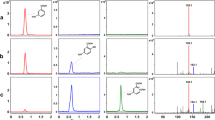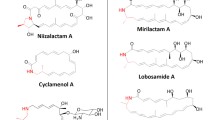Abstract
Aerobic degradation of bis-aryl ethers like the antimicrobial triclosan typically proceeds through oxygenase-dependent catabolic pathways. Although several studies have reported on bacteria capable of degrading triclosan aerobically, there are no reports describing the genes responsible for this process. In this study, a gene encoding the large subunit of a putative triclosan oxygenase, designated tcsA was identified in a triclosan-degrading fosmid clone from a DNA library of Sphingomonas sp. RD1. Consistent with tcsA’s similarity to two-part dioxygenases, a putative FMN-dependent ferredoxin reductase, designated tcsB was found immediately downstream of tcsA. Both tcsAB were found in the midst of a putative chlorocatechol degradation operon. We show that RD1 produces hydroxytriclosan and chlorocatechols during triclosan degradation and that tcsA is induced by triclosan. This is the first study to report on the genetics of triclosan degradation.









Similar content being viewed by others
References
Aylward FO, McDonald BR, Adams SM et al (2013) Comparison of 26 Sphingomonad genomes reveals diverse environmental adaptations and biodegradative capabilities. Appl Environ Microbiol 79:3724–3733. doi:10.1128/AEM.00518-13
Aziz RK, Bartels D, Best AA et al (2008) The RAST server: rapid annotations using subsystems technology. BMC Genomics 9:75. doi:10.1186/1471-2164-9-75
Barakate MS, Yang Y-X, Foo S-H et al (2000) An epidemiological survey of methicillin-resistant Staphylococcus aureus in a tertiary referral hospital. J Hosp Infect 44:19–26. doi:10.1053/jhin.1999.0635
Batie CJ, LaHaie E, Ballou DP (1987) Purification and characterization of phthalate oxygenase and phthalate oxygenase reductase from Pseudomonas cepacia. J Biol Chem 262:1510–1518
Boyd EF, Almagro-Moreno S, Parent MA (2009) Genomic islands are dynamic, ancient integrative elements in bacterial evolution. Trends Microbiol 17:47–53. doi:10.1016/j.tim.2008.11.003
Butler C, Mason JR (1997) Structure-function analysis of the bacterial aromatic ring-hydroxylating dioxygenases. Adv Microb Physiol 38:47–74
Campbell AM (1992) Chromosomal insertion sites for phages and plasmids. J Bacteriol 174:7495–7499
Chatterjee DK, Kellogg ST, Hamada S, Chakrabarty AM (1981) Plasmid specifying total degradation of 3-chlorobenzoate by a modified ortho pathway. J Bacteriol 146:639–646
Dehmel U, Engesser K-H, Timmis KN, Dwyer DF (1995) Cloning, nucleotide sequence, and expression of the gene encoding a novel dioxygenase involved in metabolism of carboxydiphenyl ethers in Pseudomonas pseudoalcaligenes POB310. Arch Microbiol 163:35–41
Dennis JJ, Zylstra GJ (2004) Complete Sequence and Genetic Organization of pDTG1, the 83 Kilobase Naphthalene Degradation Plasmid from Pseudomonas putida strain NCIB 9816–4. J Mol Biol 341:753–768. doi:10.1016/j.jmb.2004.06.034
Diaz E, Ferrandez A, Garcia JL (1998) Characterization of the hca Cluster Encoding the Dioxygenolytic Pathway for Initial Catabolism of 3-Phenylpropionic Acid in Escherichia coli K-12. J Bacteriol 180:2915–2923
Faoagali J (1995) Comparison of the immediate, residual, and cumulative antibacterial effects of Novaderm R, Novascrub R, Betadine surgical scrub, hibiclens, and liquid soap. Am J Infect Control 23:337–343. doi:10.1016/0196-6553(95)90263-5
Forbes S, Dobson CB, Humphreys GJ, McBain AJ (2014) Transient and sustained bacterial adaptation following repeated sublethal exposure to microbicides and a novel human antimicrobial peptide. Antimicrob Agents Chemother 58:5809–5817. doi:10.1128/AAC.03364-14
Frantz B, Ngai KL, Chatterjee DK et al (1987) Nucleotide sequence and expression of clcD, a plasmid-borne dienelactone hydrolase gene from Pseudomonas sp. strain B13. J Bacteriol 169:704–709
Gaillard M, Vallaeys T, Vorholter FJ et al (2006) The clc element of Pseudomonas sp. strain B13, a genomic island with various catabolic properties. J Bacteriol 188:1999–2013. doi:10.1128/JB.188.5.1999-2013.2006
Gibson DT, Koch JR, Kallio RE (1968) Oxidative degradation of aromatic hydrocarbons by microorganisms. I. Enzymatic formation of catechol from benzene. Biochemistry (Mosc) 7:2653–2662
Hay AG, Dees PM, Sayler GS (2001) Growth of a bacterial consortium on triclosan. FEMS Microbiol Ecol 36:105–112
Heidler J, Halden RU (2007) Mass balance assessment of triclosan removal during conventional sewage treatment. Chemosphere 66:362–369. doi:10.1016/j.chemosphere.2006.04.066
Jones RD, Jampani HB, Newman JL, Lee AS (2000) Triclosan: a review of effectiveness and safety in health care settings. Am J Infect Control 28:184–196. doi:10.1067/mic.2000.102378
Junker LM, Hay AG (2004) Effects of triclosan incorporation into ABS plastic on biofilm communities. J Antimicrob Ther 53:989–996
Kagle J, Hay AG (2002) Construction of a broad host-range vector conferring triclosan resistance. Biotechniques 33:490–492
Kalyon BD, Olgun U (2001) Antibacterial efficacy of triclosan-incorporated polymers. Am J Infect Control 29:124–125. doi:10.1067/mic.2001.113229
Kaschabek SR, Reineke W (1992) Maleylacetate reductase of Pseudomonas sp. strain B13: dechlorination of chloromaleylacetates, metabolites in the degradation of chloroaromatic compounds. Arch Microbiol 158:412–417
Kasuga K, Nitta A, Kobayashi M, et al (2013) Cloning of dfdA genes from Terrabacter sp. strain DBF63 encoding dibenzofuran 4,4a-dioxygenase and heterologous expression in Streptomyces lividans. Appl Microbiol Biotechnol 97:4485–4498. doi:10.1007/s00253-012-4565-3
Kim Y-M, Murugesan K, Schmidt S et al (2011) Triclosan susceptibility and co-metabolism—a comparison for three aerobic pollutant-degrading bacteria. Bioresour Technol 102:2206–2212
Lee DG, Chu K-H (2013) Effects of growth substrate on triclosan biodegradation potential of oxygenase-expressing bacteria. Chemosphere 93:1904–1911. doi:10.1016/j.chemosphere.2013.06.069
Lee DG, Zhao F, Rezenom YH et al (2012) Biodegradation of triclosan by a wastewater microorganism. Water Res 46:4226–4234. doi:10.1016/j.watres.2012.05.025
Lee DG, Cho K-C, Chu K-H (2013) Identification of triclosan-degrading bacteria in a triclosan enrichment culture using stable isotope probing. Biodegradation. doi:10.1007/s10532-013-9640-7
Lolas IB, Chen X, Bester K, Nielsen JL (2012) Identification of triclosan-degrading bacteria using stable isotope probing, fluorescence in situ hybridization and microautoradiography. Microbiology 158:2796–2804. doi:10.1099/mic.0.061077-0
Lozano N, Rice CP, Ramirez M, Torrents A (2013) Fate of triclocarban, triclosan and methyltriclosan during wastewater and biosolids treatment processes. Water Res 47:4519–4527. doi:10.1016/j.watres.2013.05.015
McBain AJ (2004) Selection for high-level resistance by chronic triclosan exposure is not universal. J Antimicrob Chemother 53:772–777. doi:10.1093/jac/dkh168
McBain AJ, Bartolo RG, Catrenich CE et al (2003) Exposure of sink drain microcosms to triclosan: population dynamics and antimicrobial susceptibility. Appl Environ Microbiol 69:5433–5442. doi:10.1128/AEM.69.9.5433-5442.2003
McMurry LM, Oethinger M, Levy SB (1998) Triclosan targets lipid synthesis. Nature 394:531–532. doi:10.1038/28970
Meade M, Waddell RL, Callahan TM (2001) Soil bacteria Pseudomonas putida and Alcaligenes xylosoxidans subsp. denitrificans inactivate triclosan in liquid and solid substrates. FEMS Microbiol Lett 204:45–48
Parikh SL, Xiao G, Tonge PJ (2000) Inhibition of InhA, the enoyl reductase from Mycobacterium tuberculosis, by triclosan and isoniazid. Biochemistry (Mosc) 39:7645–7650. doi:10.1021/bi0008940
Parke D (1992) Application of p-toluidine in chromogenic detection of catechol and protocatechuate, diphenolic intermediates in catabolism of aromatic compounds. Appl Environ Microbiol 58:2694–2697
Pfeifer F, Schacht S, Klein J, Trüper H (1989) Degradation of diphenylether by Pseudomonas cepacia. Arch Microbiol 152:515–519. doi:10.1007/BF00425479
Singer H, Muller S, Tixier C, Pillonel L (2002) Triclosan: occurrence and fate of a widely used biocide in the aquatic environment: field measurements in wastewater treatment plants, surface waters, and lake sediments. Environ Sci Technol 36:4998–5004
Stropko SJ, Pipes SE, Newman JD (2014) Genome-based reclassification of Bacillus cibi as a later heterotypic synonym of Bacillus indicus and emended description of Bacillus indicus. Int J Syst Evol Microbiol 64:3804–3809. doi:10.1099/ijs.0.068205-0
Tamura K, Peterson D, Peterson N et al (2011) MEGA5: molecular evolutionary genetics analysis using maximum likelihood, evolutionary distance, and maximum parsimony methods. Mol Biol Evol 28:2731–2739. doi:10.1093/molbev/msr121
Wittich R-M (1998) Degradation of dioxin-like compounds by microorganisms. Appl Microbiol Biotechnol 49:489–499. doi:10.1007/s002530051203
Wittich R-M, Wilkes H, Sinnwell V et al (1992) Metabolism of dibenzo-p-dioxin by Sphingomonas sp. strain RW1. Appl Environ Microbiol 58:301–306
Acknowledgments
J. Kagle’s work at Cornell University was supported by a pre-doctoral fellowship through the Howard Hughes Medical Institute. Funding for fosmid sequencing was provided by the Pennsylvania State System of Higher Education Faculty Professional Development Council.
Author information
Authors and Affiliations
Corresponding author
Rights and permissions
About this article
Cite this article
Kagle, J.M., Paxson, C., Johnstone, P. et al. Identification of a gene cluster associated with triclosan catabolism. Biodegradation 26, 235–246 (2015). https://doi.org/10.1007/s10532-015-9730-9
Received:
Accepted:
Published:
Issue Date:
DOI: https://doi.org/10.1007/s10532-015-9730-9




